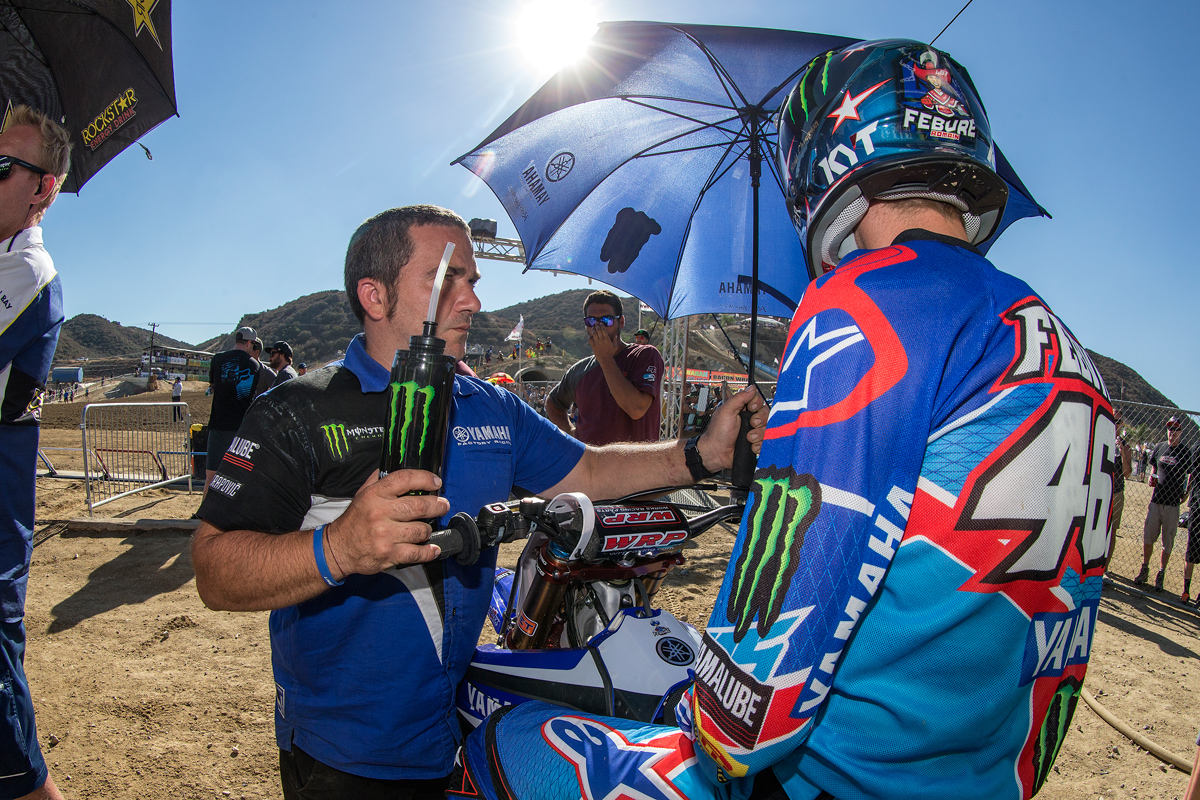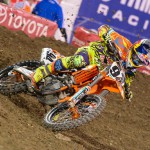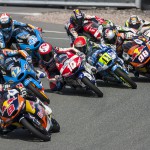Elbow guards, chest protection, knee braces, increased boot performance, neck braces, reinforced goggles…now I’m struggling. There is not a wealth of rider protection for motocrossers and off-road riders generally but I’m still trying to compute how Alpinestars’ impressive torso Tech-Air airbag system could realistically work in MXGP. It is not uncommon for the very best in the world to become unseated once or maybe even twice on their way to a podium finish at a Grand Prix and the utter plethora of bumps, jumps ‘moments’ and unsettled machinery across the path of a race would seriously make any mortal think twice about the sport when contemplating the full duress of body hits. In short: it’s pretty mad. And how would an airbag know when to deploy and also be reset for ease of use?
Alpinestars recently announced their progress and intention with a full first and independent upper body Tech-Air (prevalent in MotoGP and road racing leathers for a number of years now) system and it prompted curiosity. Neck braces have been altered and refined and now helmet technology through the likes of 6D and Leatt are addressing brain rotation and other head injuries; aside from these two strands of protection there has not been much else in the way of significant safety aids for the rider and racer.
Hardly expecting the Italian firm to divulge many details before Tech-Air launches for the off-road market we still pinned down the ever-gregarious Jeremy Appleton for some key questions at the Motocross of Nations. Apparently 2015 MXGP World Champion Romain Febvre has been wearing a set of sensors for the company in races this year and we’re shown a set of data for the Grand Prix of Switzerland at Frauenfeld back in August. The line is fairly regular through the moto until some disturbance and then suddenly a large spike – the moment when the Yamaha rider crashed into the Swiss mud. It is surprising to see such a propulsive and active sport reduced to a squiggly line and even more so to see how the rigours of a moto are actually not as haphazard as you might think. There could well be something in this…
Like neck braces there is a grey area for interpretation over airbags. The poor old collarbone is apparently much maligned with the neck technology and the same is said in some quarters for airbags (although that doesn’t stop the conviction of athletes like Marc Marquez and Valentino Rossi) but it’s common sense that the energy around the human body in the event of a crash needs to be dissipated somewhere. The effectiveness of airbags is a theme for another story but the potential for what it could do for athletes and competitors in motocross is an exciting new field…

How can you adapt this technology to off-road where a rider has to be that much more manoeuvrable on the bike?
Well, we started looking at off-road back in about 2006 actually, so it has been about ten years now and a number of riders – David Knight in particular – have been running data loggers for a considerable amount of time. The off-road environment presents some particular challenges but we are beginning to see data sets that do make sense, so there is a reasonable understanding of what is going on now with the motorcycle and on the track. Especially where we can see the rhythm of jumps and very bumpy surface riding; the system is very stable. So we have not had problems with potential for full deployment but obviously determining when a rider is going to crash is a challenge and where a lot of the [development] focus has been. The sensors are looking at what the rider’s body is doing as opposed to the motorcycle and we can determine if the rider is fairly stable or not. The analogy I can draw is if you watch helmet cam footage then there is not a huge amount of movement. There is with the bike…but the body is effectively damping a lot of that. So we can track the data but the challenge comes through determining that period in which the rider has started to lose control and we need to get the airbag fired. It is not like the data is very confused and we cannot see anything…we can see some patterns and it is about the interpretation.
The question for the system is about defining a ‘moment’ in motocross or off-road instead of a crash. Also, it is not uncommon for riders to fall and then remount; so there has to be practical issues…
It is complicated but you have to remember that the data samples we take are being processed roughly every two milliseconds. To put that in context the blink of a human eye is somewhere between two-three hundred milliseconds so we are sampling data very fast and are able to pick up vagaries very quickly, and in the road racing system what we are looking for is a trend. So if in all of these samples the data is basically saying ‘this [situation] is getting worse’ then the algorithm reaches a tipping point. The philosophy with off-road is much the same. If a rider is all over the place and losing control and eventually gets flicked over the bars or the front end washes out very quickly in a corner then in real terms we can process data very quickly and while that is going on and see potentially what is likely to happen to the rider.
I guess you cannot talk too much yet about where the airbag will be based around the torso and what will be the main priorities for protection…?
Yeah I cannot really answer at the moment because work and ideas are ongoing and I cannot give you a good picture-
So how do you see this fitting into Alpinestars’ range of protection when it comes to neck braces, chest protectors and other body armour?
Well, you know we have launched Tech-Air for the Street and in road racing, and that system is also capable of looking after you for some off-road as well. Not in a motocross environment but something more basic and simple. We’ve had David and Toby Price as well running the data logging systems at tough Enduro events and the Dakar and we see that having an airbag for off-road competition as something very achievable. It will come along… and it will be part of our portfolio of active safety products. I cannot say exactly what form it will take right now but it will be an active system where we will have looked to improve over the current passive protectors.
So what about a lead time between the system being tested and making it to dealer shelves?
It is hard to talk about the critical path and also any reference from the road racing system right now. The racers here will have used the system and the other test riders in all sorts of environments also [before it goes on sale]. I think when we get to the point when the riders are using the system with an airbag regularly then we will be better able to judge that. I cannot give a sensible time scale.
Was the decision to produce Tech-Air for road racing first a practical as well as commercial decision compared to off-road?
Well, talking about off-road we have two objectives. The first is to provide active protection to everybody that rides a motorcycle, ultimately that’s the goal. Motocross is fundamental to Alpinestars and we’ve been conscious of wanting to provide protection but also as part of the proving process of the race and street system we have been logging data with David, Toby and Marc Coma and others and that was because we wanted to see how far we could push it before we had issues with false deployment. It has actually been very stable and that increased the will to move forward. It is complicated but not insurmountable and our objective is to release a full blown airbag system.
How important is this going to be for Alpinestars? Tech-Air was launched with quite a lot of fanfare for Street a couple of years ago?
For us off-road is still at the epicentre of the company so we, more than anybody, want to bring that level of protection to our riders. So often we’ve come somewhere like the Motocross of Nations and there have been riders that cannot take part in the event [due to injury] so if we can help alleviate that then and also give something to riders who might have hurt themselves riding, training then that’s our goal. It is very important and we are not holding back with it.
Photo by Alpinestars/Ray Archer








